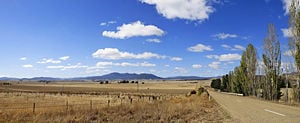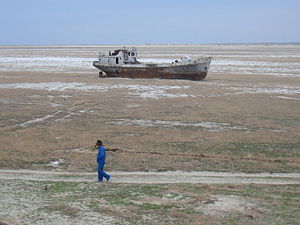Drought

A drought is an extended period of months or years when a region notes a deficiency in its water supply. Generally, this occurs when a region receives consistently below average precipitation. It can have a substantial impact on the ecosystem and agriculture of the affected region. Although droughts can persist for several years, even a short, intense drought can cause significant damage[1] and harm the local economy.[2]
Implications
Drought is a normal, recurring feature of the climate in most parts of the world. Having adequate drought mitigation strategies in place can greatly reduce the impact. Recurring or long-term drought can bring about desertification. Recurring droughts in the Horn of Africa have created grave ecological catastrophes, prompting massive food shortages, still recurring. To the north-west of the Horn, the Darfur conflict in neighboring Sudan, also affecting Chad, was fueled by decades of drought; combination of drought, desertification and overpopulation are among the causes of the Darfur conflict, because the Arab Baggara nomads searching for water have to take their livestock further south, to land mainly occupied by non-Arab farming peoples.[3]
According to a UN climate report, the Himalayan glaciers that are the sources of Asia's biggest rivers—Ganges, Indus, Brahmaputra, Yangtze, Mekong, Salween and Yellow—could disappear by 2035 as temperatures rise.[4] Approximately 2.4 billion people live in the drainage basin of the Himalayan rivers.[5] India, China, Pakistan, Bangladesh, Nepal and Myanmar could experience floods followed by droughts in coming decades. Drought in India affecting the Ganges is of particular concern, as it provides drinking water and agricultural irrigation for more than 500 million people.[6] Paradoxically, some proposed short-term solutions to global warming also carry with them increased chances of drought.[7]
In 2005, parts of the Amazon basin experienced the worst drought in 100 years.[8] A July 2006 article reported Woods Hole Research Center results showing that the forest in its present form could survive only three years of drought. Scientists at the Brazilian National Institute of Amazonian Research argue in the article that this drought response, coupled with the effects of deforestation on regional climate, are pushing the rainforest towards a "tipping point" where it would irreversibly start to die. It concludes that the rainforest is on the brink of being turned into savanna or desert, with catastrophic consequences for the world's climate. According to the WWF, the combination of climate change and deforestation increases the drying effect of dead trees that fuels forests fires.[9]
Causes
Generally, rainfall is related to the amount of water vapor in the atmosphere, combined with the upward forcing of the air mass containing that water vapor. If either of these is reduced, the result is drought.
Factors include:
- Above-average prevalence of high pressure systems.
- Winds carrying continental, rather than oceanic air masses (ie. reduced water content).
- El Nino (and other oceanic temperature cycles).
- Deforestation.
Stages of drought

As a drought persists, the conditions surrounding it gradually worsen and its impact on the local population gradually increases. Droughts go through three stages before their ultimate cessation:[10]
- Meteorological drought is brought about when there is a prolonged period with less than average precipitation. Meteorological drought usually precedes the other kinds of drought.
- Agricultural droughts are droughts that affect crop production or the ecology of the range. This condition can also arise independently from any change in precipitation levels when soil conditions and erosion triggered by poorly planned agricultural endeavors cause a shortfall in water available to the crops. However, in a traditional drought, it is caused by an extended period of below average precipitation.
- Hydrological drought is brought about when the water reserves available in sources such as aquifers, lakes and reservoirs falls below the statistical average. Like an agricultural drought, this can be triggered by more than just a loss of rainfall. For instance, Kazakhstan was recently awarded a large amount of money by the World Bank to restore water that had been diverted to other nations from the Aral Sea under Soviet rule.[11] Similar circumstances also place their largest lake, Balkhash, at risk of completely drying out.[12]
Consequences
Periods of drought can have significant environmental, economic and social consequences. The most common consequences include:
- Death of livestock.
- Reduced crop yields.
- Wildfires, such as Australian bushfires, are more common during times of drought.
- Shortages of water for industrial users.[13]
- Desertification
- Dust storms, when drought hits an area suffering from desertification and erosion.
- Malnutrition, dehydration and related diseases.
- Famine due to lack of water for irrigation.
- Social unrest.
- Mass migration, resulting in internal displacement and international refugees.
- War over natural resources, including water and food.
- Reduced electricity production due to insufficient available coolant.
- Snakes have been known to emerge and snakebites become more common.[14]
The effect varies according to vulnerability. For example, subsistence farmers are more likely to migrate during drought because they do not have alternative food sources. Areas with populations that depend on subsistence farming as a major food source are more vulnerable to drought-triggered famine. Drought is rarely if ever the sole cause of famine; socio-political factors such as extreme widespread poverty play a major role. Drought can also reduce water quality, because lower water flows reduce dilution of pollutants and increase contamination of remaining water sources.
Drought mitigation strategies
- Desalination of sea water for irrigation or consumption.
- Drought monitoring - Continuous observation of rainfall levels and comparisons with current usage levels can help prevent man-made drought. For instance, analysis of water usage in Yemen has revealed that their water table (underground water level) is put at grave risk by over-use to fertilize their Khat crop.[15] Careful monitoring of moisture levels can also help predict increased risk for wildfires, using such metrics as the Keetch-Byram Drought Index or Palmer Drought Index.
- Land use - Carefully planned crop rotation can help to minimize erosion and allow farmers to plant less water-dependent crops in drier years.
- Rainwater harvesting - Collection and storage of rainwater from roofs or other suitable catchments.
- Recycled water - Former wastewater (sewage) that has been treated and purified for reuse.
- Transvasement - Building canals or redirecting rivers as massive attempts at irrigation in drought-prone areas.
- Water restrictions - Water use may be regulated (particularly outdoors). This may involve regulating the use of sprinklers, hoses or buckets on outdoor plants, the washing of motor vehicles or other outdoor hard surfaces (including roofs and paths), topping up of swimming pools, and also the fitting of water conservation devices inside the home (including shower heads, taps and dual flush toilets).
- Cloud seeding - an artificial technique to induce rainfall.[16]
See also
Notes
- ↑ Living With Drought Australian Bureau of Meteorology.
- ↑ Australian Drought and Climate Change Lilith Gallery of Toronto. Retrieved January 9, 2008.
- ↑ Looking to water to find peace in Darfur Reuters. Retrieved January 9, 2008.
- ↑ Vanishing Himalayan Glaciers Threaten a Billion Planet Ark. Retrieved January 9, 2008.
- ↑ Big melt threatens millions, says UN People and the Planet. Retrieved January 9, 2008.
- ↑ Ganges, Indus may not survive: climatologists Rediff India Abroad. Retrieved January 9, 2008.
- ↑ Brahic, Catherine. 2007. Sunshade' for global warming could cause drought New Scientist. Retrieved January 9, 2008.
- ↑ Environmental News Service - Amazon Drought Worst in 100 Years Environment News Service. Retrieved January 9, 2008.
- ↑ Climate change a threat to Amazon rainforest, warns WWF World Wide Fund for Nature. Retrieved January 9, 2008.
- ↑ NOAA Fact Sheet NOAA. Retrieved January 9, 2008.
- ↑ Dam project aims to save Aral Sea BBC News. Retrieved January 9, 2008.
- ↑ Kazakh lake 'could dry up' BBC News. Retrieved January 9, 2008.
- ↑ Parched village sues to shut tap at Coke San Francisco Chronicle. Retrieved January 9, 2008.
- ↑ Australians Face Snake Invasion BBC News. Retrieved January 9, 2008.
- ↑ Yemen's khat habit soaks up water BBC News. Retrieved January 9, 2008.
- ↑ Cloud seeding helps alleviate drought China Daily. Retrieved January 9, 2008.
ReferencesISBN links support NWE through referral fees
- Chambers, Catherine. Drought (Disasters in Nature). Chicago, IL: Heinemann Library, 2001. ISBN 157572426X
- Collier, Michael and Robert H. Webb. Floods, Droughts, and Climate Change. Tucson, AZ: University of Arizona Press, 2002. ISBN 0816522502
- Wilhite, Donald A. Drought and Water Crises: Science, Technology, and Management Issues. Boca Raton, FL: CRC Press, 2005. ISBN 0824727711
Credits
New World Encyclopedia writers and editors rewrote and completed the Wikipedia article in accordance with New World Encyclopedia standards. This article abides by terms of the Creative Commons CC-by-sa 3.0 License (CC-by-sa), which may be used and disseminated with proper attribution. Credit is due under the terms of this license that can reference both the New World Encyclopedia contributors and the selfless volunteer contributors of the Wikimedia Foundation. To cite this article click here for a list of acceptable citing formats.The history of earlier contributions by wikipedians is accessible to researchers here:
The history of this article since it was imported to New World Encyclopedia:
Note: Some restrictions may apply to use of individual images which are separately licensed.